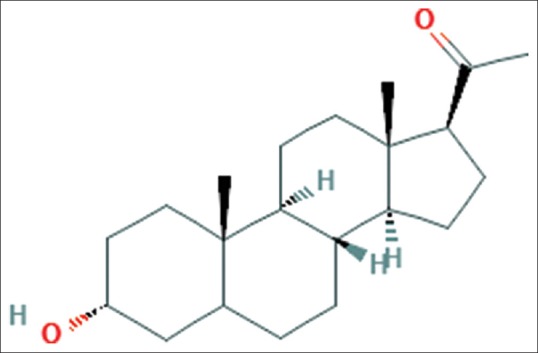To the Editor,
The Gamma-amino-butyric acid (GABA)-A receptors system present in central nervous system (CNS) is responsible for CNS inhibition which is mediated by inhibitory neurotransmitters. GABA and glycine are the important inhibitory neurotransmitters with some inhibitory response mediated by acetyl choline and dopamine as well. Several group of drugs under the broad classification of anxiolytics, anticonvulsants, barbiturates, general anesthetics, ethanol, and neurostereroids like allopregnanolone, progesterone, testosterone, and tetrahydrodeoxycorticosterone (THDOC) acts through GABA-A receptor agonism.[1]
Of all the GABA-A receptors agonists described above, neurosteroids are the only agonists which are produced in human body mainly in brain, placenta, adrenal glands. In the brain, neurosteroids are synthesized in oligodendrocytes, astrocytes, schwann cells, purkinje cells, hippocampal neurons, retinal amacrine, and ganglion cells. Neurosteroids are considered the most potent endogenous modulators of GABA-A receptors. Its production and levels decrease in acute and chronic painful conditions. Downregulation of GABA-A receptors or impaired spinal GABA-A receptors due to painful conditions has been found to be responsible for chronic pain later.[2] Studies have shown that spinal neurosteroids have been useful in addressing painful neuropathic and acute surgically mediated pain by various mechanisms.
Allopregnanolone is endogenously synthesized from progesterone in the brain and functions as an inhibitory pregnane neurosteroid. It is a potent positive allosteric modulator of the action of GABA at GABA-A receptor [Figure 1]. It mediates its action through glycine, L and T calcium channels. All neurosteroids including allopregnanolone on secretion act via autocrine and paracrine mechanisms. In acute stress, the neuroendocrine response is affected which is mediated by the hypothalamic-pituitary axis (HPA). This happens by noradrenergic and corticosteroid-mediated regulation of corticotrophin-releasing hormone release. The behavioral effects and physiological consequences of allopregnanolone resemble benzodiazepines and ethanol. Experimental studies have shown that allopregnanolone also confers neuroprotective, antidepressant, and anxiolytic effects.[3]
Figure 1.

Structure of allopregnanolone (Image source: National Center for Biotechnology Information). PubChem Compound Database; CID = 22833567, https://pubchem.ncbi.nlm.nih.gov/compound/22833567 (accessed Dec 23, 2018)
Cancer chemotherapeutic agents like vinca alkaloids and platinum-based compounds have been known to cause peripheral neuropathy. Once neuropathy starts manifesting, there is suboptimal treatment and excessive suffering faced by the patient. Prophylactic or concomitant use of allopregnanolone in animals receiving neurotoxic chemotherapy have been found to be useful in preventing neuropathic pain.[4] In a study by Afrazi and Esmaeili-Mahani performed on streptozotocin-induced diabetic rats, allopregnanolone did prevent hyperglycemia-induced peripheral neuropathy and motor deficit in a dose range of 5 and 20 mg/kg.[5] However, repeated exposure to allopregnanolone has shown to be responsible for tolerance. The tolerance to its regular use has not been studied and completely understood yet.
The dosing, frequency, and duration of treatment has not be clearly described in studies yet. Researchers have used doses ranging from 4 to 20 mg/kg/day once to/twice daily intravenously/intramuscularly/subcutaneously either for 3 days or 7 days and have found variable results. Allopregnanolone appears to be a multifaceted neurosteroid found useful in experimental animals in alleviating acute pain, chronic neuropathic pain due to systemic diseases like diabetes mellitus and ongoing chemotherapy. It also has antidepressant, neuroprotective, and anxiolytic effects. Further studies could throw light on the dose, optimal route of administration, duration, and adverse effect of allopregnonalone when used in above mentioned conditions.
Financial support and sponsorship
Nil.
Conflicts of interest
There are no conflicts of interest.
References
- 1.Turkmen S, Backstrom T, Wahlstrom G, Andreen L, Johansson I-M. Tolerance to allopregnanolone with focus on the GABA-A receptor. Br J Pharmacol. 2011;162:311–27. doi: 10.1111/j.1476-5381.2010.01059.x. [DOI] [PMC free article] [PubMed] [Google Scholar]
- 2.Janssen SP, Truin M, Van Kleef M, Joosten EA. Differential GABAergic disinhibition during the development of painful peripheral neuropathy. Neuroscience. 2011;184:183–94. doi: 10.1016/j.neuroscience.2011.03.060. [DOI] [PubMed] [Google Scholar]
- 3.Patte-Mensah C, Meyer L, Taleb O, Mensah-Nyagan AG. Potential role of allopregnanolone for a safe and effective therapy of neuropathic pain. Prog Neurobiol. 2014;113:70–8. doi: 10.1016/j.pneurobio.2013.07.004. [DOI] [PubMed] [Google Scholar]
- 4.Meyer L, Patte-Mensah C, Taleb O, Mensah-Nyagan AG. Allopregnanolone prevents and suppresses oxaliplatin-evoked painful neuropathy: Multi-parametric assessment and direct evidence. Pain. 2011;152:170–81. doi: 10.1016/j.pain.2010.10.015. [DOI] [PubMed] [Google Scholar]
- 5.Afrazi S, Esmaeili-Mahani S. Allopregnanolone suppresses diabetes-induced neuropathic pain and motor deficit through inhibition of GABAA receptor down-regulation in the spinal cord of diabetic rats. Iran J Basic Med Sci. 2014;17:312–7. [PMC free article] [PubMed] [Google Scholar]


